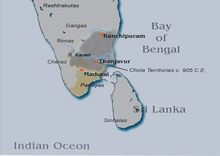Aditya I
Aditya I (c. 870/71 – c. 907 CE[1]), the son of Vijayalaya, was the Chola king who extended the Chola dominions by the conquest of the Pallavas and occupied the Western Ganga Kingdom.[2]
| Aditya I | |
|---|---|
| Rajakesari | |
 Chola Territories c. 905 CE | |
| Reign | 870–907 CE |
| Predecessor | Vijayalaya Chola |
| Successor | Parantaka I |
| Born | Unknown Thanjavur |
| Died | 907 CE |
| Queen | Tribhuvanamadeviyar Ilangon Pichchi |
| Issue | Parantaka |
| Father | Vijayalaya Chola |
| List of Chola kings and emperors | ||||||||||||||||||||||||||||
|---|---|---|---|---|---|---|---|---|---|---|---|---|---|---|---|---|---|---|---|---|---|---|---|---|---|---|---|---|
| Early Cholas | ||||||||||||||||||||||||||||
| Interregnum (c. 200 – c. 848) | ||||||||||||||||||||||||||||
| Medieval Cholas | ||||||||||||||||||||||||||||
|
||||||||||||||||||||||||||||
| Later Cholas | ||||||||||||||||||||||||||||
|
||||||||||||||||||||||||||||
| Related dynasties | ||||||||||||||||||||||||||||
|
||||||||||||||||||||||||||||
| Chola society | ||||||||||||||||||||||||||||
Pallava Civil War
During the invasion of the Chola country, the Pandya king Varagunavarman II became an ally of Nripatunga, the eldest son of the Pallava King Nandivarman III.
When Nandivarman died in 869 CE differences arose between Nripatunga and his stepbrother Aparajita, probably owing to the latter's ambition to rule the kingdom on his own right. Both sides looked for allies. Nripatunga continued to have Varaguna Pandya by his side while Aparajita allied with the Ganga king Prithvipathi I and with Aditya Chola I. The rival armies met at Thirupurambiyam near Kumbakonam c. 885 CE. The armies of Pandyas and Nripatunga Pallava were routed by Aparajita Pallava and Aditya I Chola. But Some Inscriptions purely clarified Nirpatunga Was not alive during the war. So it is the war between Pallvas and Pandiyas to establish Legal Supremacy
Ascendancy
Although the victor of the Thirupurambiyam battle was Aparajita, the real gains went to Aditya I Chola. This battle ensured the end of Pandya power in the south. Pandya Varagunavarman renounced his throne and followed an ascetic life. The grateful Aparajita not only allowed Aditya I Chola to keep the territories won by Vijayalaya Chola, but also to add new territories from the defeated Pandyas.
Invasion of the Pallava country
During 903 CE, the 32nd year of his reign, Aditya I Chola, not satisfied with his subordinate position, planned and carried out an attack on his erstwhile overlord, the Pallava king Aparajita. In the battle that ensued, Aditya pounced upon Aparajita when he was mounted on an elephant and killed him. That spelt the end of the Pallava rule in Tondaimandalam (north Tamil Nadu) and the whole of the Pallava kingdom became Chola territory. This marked the effective end of the once great Pallava empire in the history of South India.
The conquest of the Tondaimandalam earned for Aditya I the epithet "Tondainadu pavina Rajakesarivarman" (தொண்டைநாடு பாவின இராசகேசரிவர்மன்) - "Rajakesarivarman who overran Tondainadu".
Relations with the Cheras
Friendly relations appear to have existed between the Cheras (the Perumals) and the Cholas during the reign of Aditya I.[1] The Chera contemporary Sthanu Ravi was a partner in Chola king Rajakesari Varma's campaign in Kongu country (central Tamil Nadu).[3] King Rajakesari Varma can be identified either with Aditya or Srikantha Chola.[4][1]
It is known that Aditya I's son, Parantaka I, married a Chera princess (the Kizhan Adikal).[5]
Aditya’s contributions to Temples
Aditya I is known to have built a number of temples 108 for Shiva along the banks of the Kaveri. The Kanyakumari inscription gives us the information that Aditya I was also known by the surname Kodandarama. There is a temple near the town of Tondaimanarrur called Kodandarameshvaraa, also mentioned in its inscriptions by the name Adityesvara. This seems to have been built by Aditya I. He also revised Annamalaiyar sanctum in Thiruvaannamalai during 872 – 900. Aditya also was the patron of Sureswara and prabhakara who were pupils of kumarila bhatta a favourite student of Adisankaracharya. The author of that work do confirm that they settled in the banks of Kaveri (Sibishu kaveriteere meaning in the country of cholas (Sibi is an ancestor of Cholas)) and were employed by Manukula Adityan (Aditya Chola).
Death and Succession
In an inscription Aditya I is distinguished by the epithet in Tamil – (தொண்டைமானரூர் துஞ்சின உடையார் Thondaimaanaruur thunjina udaiyaar). "The king who died at Tondaimanarrur". Aditya I died in 907 CE at Tondaimanarrur. His son Parantaka I built a Shiva temple over his ashes. Aditya I was survived by his queens Ilangon Pichchi and Vayiri Akkan alias Tribhuvana Madeviyar. Besides these two queens, Aditya I also had a mistress named Nangai Sattaperumanar as evidenced from an inscription.
Aditya I had a long and victorious reign during which he laid the foundation of the future greatness of the Chola empire.
References
- Ali, Daud. "The Death of a Friend: Companionship, Loyalty and Affiliation in Chola South India". Studies in History, vol. 33, no. 1, Feb. 2017, pp. 36–60.
- Sen, Sailendra (2013). A Textbook of Medieval Indian History. Primus Books. pp. 46–49. ISBN 978-9-38060-734-4.
- Narayanan, M. G. S. Perumāḷs of Kerala. Thrissur (Kerala): CosmoBooks, 2013. 435-437.
- Narayanan, M. G. S. Perumāḷs of Kerala. Thrissur (Kerala): CosmoBooks, 2013. 436-37.
- George Spencer, 'Ties that Bound: Royal Marriage Alliance in the Chola Period', Proceedings of the Fourth International Symposium on Asian Studies (Hong Kong: Asian Research Service, 1982), 723.
- Tamil And Sanskrit Inscriptions Chiefly Collected in 1886 - 87, E. Hultzsch, PhD, Published by Archaeological Survey of India, New Delhi
- Nilakanta Sastri, K. A. (1935). The CōĻas, University of Madras, Madras (Reprinted 1984).
- Nilakanta Sastri, K. A. (1955). A History of South India, OUP, New Delhi (Reprinted 2002).
| Preceded by Vijayalaya Chola |
Chola 871–907 CE |
Succeeded by Parantaka Chola I |